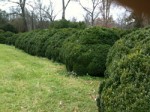
English boxwood is an evergreen shrub native to western and southern Europe, northwest Africa and southwest Asia where they grow in open woodlands and rocky hillsides. It and is member of the Buxaceae family that consists of 123 species in 6 genera. Plants grow only 1″/year eventually reaching up to 4-5′ tall but can be kept at 6-12″ by a yearly pruning. The oval to oblong leaves are up to 1/2″ long and have smooth margins. They are glossy apple green in the spring and mature by fall to dark green. In early spring the inconspicuous flowers appear in axillary clusters and are creamy white to green or yellow. Boxwood makes a magnificent hedge in a formal garden where they can provide strong structure that looks attractive all year long. As a bonus they are fabulous Christmas greens and can be made into table top trees, kissing balls, and wreaths as well as used in mixed greens arrangements. They have a long vase life so can be used early in the season and will still look great a month later. Even if used without a water source they will dry well and be an attractive addition to your holiday décor. The genus name, Buxus, is the Latin name for the plant. The specific epithet, sempervirens, comes from the Latin words semper meaning always and virens meaning green and refers to their year around green foliage. The cultivar name ‘Suffruticosa’ comes from the Latin words sub meaning under and fruticosus meaning full of leaves, and refers to the high density of the leaves.
Type: Woody evergreen shrub.
Outstanding Feature: Small size; fine textured evergreen leaves.
Form: Dense rounded cloud like mounds when mature.
Growth Rate: Very slow.
Bloom: Inconspicuous flowers in spring.
Size: 5’ H x 4’ W, but may be kept 6-12” tall.
Light: Full sun – part shade.
Soil: Average, well drained soil; once established box will withstand some dryness.
Fertilizer: Apply 10:10:10 in spring.
Hardiness: Zones 5-8.
Pests and Diseases: Nemotodes, leaf miner, Phytophthora root rot, spider mites, and psyllids can attack boxwoods but usually do not present a significant problem; good cultivation practices will help avoid them. Deer resistant.
Propagation: Soft or hardwood cuttings taken in summer to fall root easily in sand.
Comments: English box is very dense and can be harvested for greens without damaging the plant. Pick stems that are on the sunny side of the bush and regrowth will occur more quickly than you would guess.
Some people claim that English boxwood smells like cat urine but I have cats and smell no similarity although I admit that I can smell a distinct and unique fragrance.
